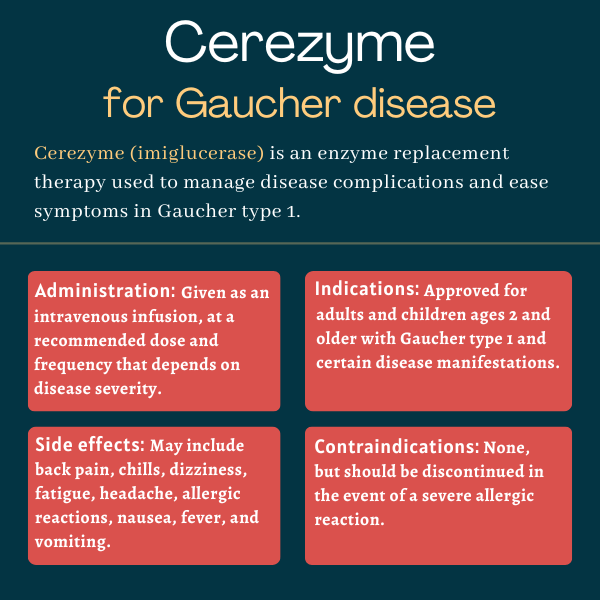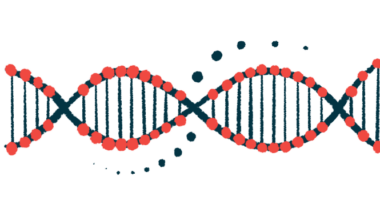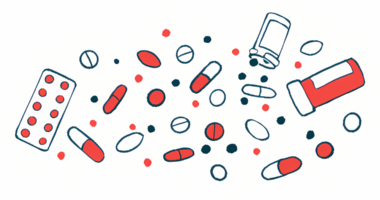Cerezyme (imiglucerase) for Gaucher disease
Last updated March 31, 2025, by Ines Martins, PhD

What is Cerezyme for Gaucher disease?
Cerezyme (imiglucerase) is an enzyme replacement therapy (ERT) approved to help manage certain disease complications and ease symptoms in adults and children 2 and older with Gaucher disease type 1.
Delivered via into-the-vein, or intravenous, infusions, it works to reduce the toxic accumulation of certain fatty molecules that drives tissue damage in Gaucher.
The therapy was originally developed by Genzyme, which was acquired by Sanofi in 2011.
Therapy snapshot
| Brand name: | Cerezyme |
| Chemical name: | Imiglucerase |
| Usage: | Used to manage disease complications and ease symptoms in Gaucher disease type 1 |
| Administration: | Intravenous infusion |
How does Cerezyme work?
Gaucher disease is a lysosomal storage disorder, in which a missing enzyme in lysosomes — organelles that function as the cell’s recycling centers — causes the accumulation of certain molecules to toxic levels.
In Gaucher, mutations in the GBA1 gene result in a deficiency of the glucocerebrosidase enzyme in lysosomes, causing the toxic buildup of fatty molecules called glucocerebrosides in various tissues and organs.
Gaucher type 1, the most common type of Gaucher disease in North America and Europe, mainly affects the spleen, liver, and bone marrow, while sparing the brain and spinal cord. Gaucher disease symptoms include fatigue and bleeding due to low levels of red blood cells and platelets (cell fragments involved in blood clotting), bone problems, and an enlarged spleen and liver.
Cerezyme aims to deliver a working version of the missing glucocerebrosidase enzyme to the bloodstream, where it can be picked up by cells throughout the body to reduce the toxic accumulation of glucocerebroside.
The delivered, lab-made enzyme, called imiglucerase, is similar to a modified form of placental glucocerebrosidase that was used in Cerezyme’s predecessor Ceredase (alglucerase). Also developed by Genzyme, Ceredase was the first approved ERT for Gaucher type 1. It was withdrawn from the market following the approval of newer, safer ERTs.
The imiglucerase and alglucerase enzymes differ by only one amino acid (a building block of proteins). Another key difference is that alglucerase was extracted from human placental tissue, while imiglucerase is made using recombinant DNA technology, meaning it is produced by lab-grown cells modified to carry the GBA1 gene. The enzyme then undergoes a series of reactions that improve its ability to reach the cells of interest.
Who can take Cerezyme?
Cerezyme was approved by the U.S. Food and Drug Administration in May 1994 to treat adults and children ages 2 and older with Gaucher type 1 that results in at least one of the following conditions:
- anemia, or low red blood cell counts
- thrombocytopenia, or low blood platelet counts
- bone disease
- hepatomegaly, or enlarged liver
- splenomegaly, or enlarged spleen.
The medication was approved in Europe in 1997 as a long-term treatment for people with Gaucher type 1, as well as those with type 3 Gaucher disease with significant non-neurological symptoms, including at least one of those in the list above. Gaucher type 3 shares many of the same symptoms of type 1, but is also marked by slowly progressing neurological symptoms.
Who should not take Cerezyme?
Cerezyme’s prescribing information does not list any contraindications.
However, it contains a boxed warning noting some patients may experience severe allergic reactions to the medication, including a life-threatening reaction called anaphylaxis. This reaction can occur early in the course of treatment and after extended duration of therapy.
Cerezyme treatment should be started in a healthcare setting with appropriate medical support measures, such as cardiopulmonary resuscitation equipment. If a severe allergic reaction occurs, the therapy should be discontinued and appropriate treatment, including use of epinephrine (the active ingredient in an EpiPen), should be immediately started.
How is Cerezyme administered?
Cerezyme is given by a healthcare professional as an infusion into the bloodstream at a dose and frequency that depends on disease severity. It’s available in single-dose vials containing 400 units of imiglucerase as a white to off-white powder, which must be dissolved in 10.2 mL of sterile water before use.
The recommended dose of Cerezyme ranges from 2.5 units per kg of body weight, administered three times a week, to 60 units/kg given once every two weeks. The latter is the dosage for which most data are available, but a patient’s physician will determine the best initial dose and any dose adjustments based on disease manifestations and therapeutic goals.
Cerezyme’s infusion duration varies based on a person’s weight:
- Those weighing less than 18 kg (about 40 pounds) will receive a final volume of 100 mL over two hours.
- Those weighing 18 kg or more should receive a final volume of 100-200 mL in one to two hours.
Because Cerezyme can cause severe allergic reactions, including anaphylaxis, it should be administered under supervision of a healthcare provider who knows how to manage these reactions, and in a setting where monitoring equipment and support measures are available. If an allergic reaction occurs, the infusion should be stopped and appropriate management given to the patient.
For people who have previously experienced an allergic reaction to the medication, reducing the infusion rate and administering antihistamines and corticosteroids before each infusion should be considered. These patients should also be closely monitored for the potential occurrence of new allergic reactions, and if that reaction is severe, treatment should be discontinued.
Cerezyme in Gaucher clinical trials
Cerezyme’s approval in the U.S. was supported in large part by a pivotal Phase 3 clinical trial that tested whether the medication was at least as safe and effective at controlling Gaucher type 1 as its predecessor Ceredase.
Since then, many analyses of data from the International Collaborative Gaucher Group Gaucher Registry, a Sanofi-sponsored registry that includes data from more than 6,000 Gaucher patients worldwide, have supported its long-term safety and efficacy in managing certain key disease parameters in adults and children with the disease.
Phase 3 trial
The Phase 3 trial, dubbed RC 91-0110, was conducted in 1992 at two U.S. sites. It enrolled 30 people, ages 12 to 69, who had not previously received an ERT and who had lower-than-normal levels of hemoglobin, the protein in red blood cells that transports oxygen.
Participants were randomly assigned to receive either Cerezyme or Ceredase, at a dose of 60 mg/kg, once every two weeks for six months. The study’s main goals were to determine changes in blood levels of hemoglobin and platelets, as well as in liver and spleen volume, as assessed with MRI or CT scans.
Results showed that six months of Cerezyme treatment resulted in an increase in hemoglobin levels by a mean of 1.9 g/dL with the second-generation ERT and 1.6 g/dL with Ceredase. Platelet counts were increased by 33% with Cerezyme and by 26% with Ceredase.
Cerezyme led to a 35% reduction in spleen volume and an 11% decrease in liver volume, while Ceredase led to a 30% drop in spleen volume and 10% reduction in liver volume.
All these changes were statistically significant when compared with values at the study’s start, but there were no significant differences between treatment groups, confirming that Cerezyme was at least as effective as Ceredase.
Additional analysis of secondary measures also demonstrated that the two ERTs were similarly effective at reducing blood biomarkers of the disease, easing muscle loss, and improving bone health.
Extended study
After completing the RC 91-0110 study, all participants entered an extended study, dubbed RC 92-0501, in which all were set to continue to receive their assigned treatment for the first three months. After that, all would receive Cerezyme for a total treatment duration of up to 26 months (about two years).
All but one patient — who was originally assigned Ceredase — completed the extended study and were included in the efficacy analysis. Data showed that hemoglobin and platelet levels continued to increase after the main trial ended.
At the end of the extended study, 86% of patients achieved a main goal of a hemoglobin level increase of at least 1 mg/dL, and 45% of those with hemoglobin deficiency at the start of the main trial achieved normal levels.
Similarly, about two-thirds (66%) of patients saw their platelet counts rise by at least 30% — one of the study’s main goals — and more than half (52%) had increases of 50% or more.
Spleen volume was reduced by 57% after two years, and liver volume decreased by a mean of 20%. Most patients showed a greater than 10% reduction in liver volume (86%) and spleen volume (97%), meeting another study goal.
Bone improvements were also reported for most (64%) of evaluable patients.
While participants with hemoglobin increases by at least 1 mg/dL were eligible for dose reductions, these patients maintained their treatment responses.
At the end of the extended study, no significant differences in efficacy results were observed between patients who were initially given Cerezyme and those given Ceredase.
Common side effects of Cerezyme
The most common side effects of Cerezyme reported in clinical studies or postmarketing reports include:
- back pain
- chills
- dizziness
- fatigue
- headache
- allergic reactions
- nausea
- fever
- vomiting.
Allergic reactions
Cerezyme carries a boxed warning noting that severe allergic reactions, including anaphylaxis, have been reported in patients given the therapy, both in the early phases of treatment and after long-term use.
Other reported allergic reactions with Cerezyme have included symptoms such as itching, skin redness, hives, swelling under the skin, chest discomfort, shortness of breath, cough, bluish discoloration of the skin due to diminished oxygen, abnormally fast heartbeat, and low blood pressure.
About 15% of Cerezyme-treated patients develop antibodies against imiglucerase, the enzyme delivered by Cerezyme, and these patients are more likely to have allergic reactions. For this reason, doctors may want to monitor patients for the development of these antibodies during the first year of treatment.
Due to the risk of life-threatening allergic reactions at any time during Cerezyme treatment, the ERT should only be administered under the supervision of a healthcare provider who is knowledgeable in managing anaphylaxis. Treatment also should be started in a facility with appropriate monitoring and medical support measures, including access to cardiopulmonary resuscitation equipment.
Patients also should be informed about the symptoms of anaphylaxis or other life-threatening allergic reactions, so they can seek immediate medical care if these symptoms develop.
Infusion reactions
There have been reports of infusion-related reactions in people treated with Cerezyme. These may include swelling under the skin, itching, rash, hives, chest discomfort, chills, fatigue, fever, and high blood pressure, as well as burning, discomfort, or swelling at the infusion site.
If such a reaction occurs, symptoms may ease with a reduction in the infusion rate, a temporary halt in the infusion, and/or with the administration of antihistamines or anti-fever medications. Patients with a history of infusion-related reactions should be closely monitored when Cerezyme treatment is restarted.
Use in pregnancy and breastfeeding
Available data from more than 500 pregnancies suggest that Cerezyme is not associated with an increased risk of major birth defects, miscarriage, or other adverse effects for the mother or the fetus.
No animal studies have been conducted to assess the effects of the therapy during pregnancy.
Pregnancy can worsen Gaucher type 1 symptoms or lead to the development of new symptoms. Untreated patients experiencing symptoms may develop complications during pregnancy, including enlarged spleen and liver, as well as low platelet levels, which can interfere with normal fetal growth and lead to excessive bleeding.
An ongoing Gaucher registry is monitoring pregnancy outcomes in women exposed to Cerezyme during pregnancy. Patients who fit this criterion and their healthcare providers are encouraged to contact the registry to participate.
Some evidence suggests that a small amount of imiglucerase is able to pass into human breast milk, but no adverse effects related to Cerezyme exposure during breastfeeding have been reported to date. Patients who are considering breastfeeding should carefully consider the benefits of treatment along with the potential risks that Cerezyme exposure or their own condition may have on their babies.
Gaucher Disease News is strictly a news and information website about the disease. It does not provide medical advice, diagnosis, or treatment. This content is not intended to be a substitute for professional medical advice, diagnosis, or treatment. Always seek the advice of your physician or other qualified health provider with any questions you may have regarding a medical condition. Never disregard professional medical advice or delay in seeking it because of something you have read on this website.
Recent Posts
- Abcertin meets Cerezyme biosimilar criteria in Phase 1 study
- Gaucher disease diagnosis speeds up, but complications still common
- A week in the life of a working mom, wife, and caregiver
- Yes, I have Gaucher disease, but I don’t feel ‘sick’
- New Jersey’s newborn screening ID’s babies with Gaucher disease
Related articles






